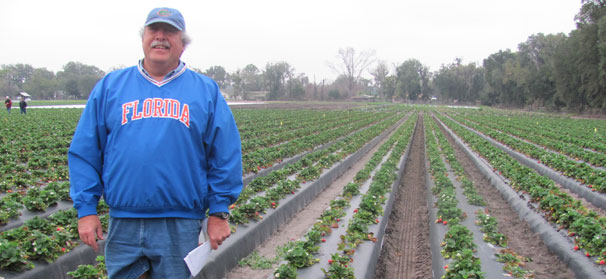
May 20, 2011How do you replace methyl bromide?
Methyl bromide has worked wonders for Florida strawberry growers over the years, eliminating a broad spectrum of pests in a fairly straightforward manner. Stricter environmental controls and an international agreement have slowly phased out use of the fumigant, however, forcing growers to find alternatives.
That’s easier said than done, but Joe Noling, a professor and nematology specialist with the University of Florida, is working with the Florida Strawberry Growers Association (FSGA) to find a way. Noling, who’s been at it for more than a decade, said the primary goal of his research is to “transition Florida strawberry growers to alternatives by developing guidelines and recommendations for their use (that) minimize performance inconsistency, production losses and grower uncertainty.”
In February, Noling showed members of the North American Strawberry Growers Association a 3-acre research plot near Plant City, Fla., where methyl bromide-alternative research is being conducted. The plot, managed by FSGA, is one of many such large-scale demonstration sites in the region, he said.
He described some of the research being done on the plot: Seventeen treatments were being evaluated in two-row, 500-foot strips. Each treatment had a sign on it that identified the fumigant, the broadcast-equivalent rate, the rate per acre and other particulars.
So far, the research generally supports the recommendation to use a formulation of 1,3-D and chloropicrin to replace methyl bromide, but that recommendation could change given shifting regulations, market conditions, production practices and the appearance of new products, Noling said.
By itself, chloropicrin has proven effective against diseases, but not nematodes or weeds. Because of that, other chemicals need to be added to broaden chloropicrin’s spectrum of pest control, he said.
Like other strawberry fields in Florida, the research plot consistently battles infestation by the sting nematode, one of the state’s major pest problems. The tiny parasite affects roughly 40 percent of the state’s strawberry acreage, and also does damage in cantaloupe, eggplant, tomato, pepper, onion, sweet corn, yellow squash and zucchini fields, according to Noling.
He said the sting nematode problem wouldn’t be going away anytime soon.
“As long as EPA continues to make regulatory changes to pesticide use practices, and as long as the environment and production economics force growers to consider and implement new production practices, and as long as we continue to learn more about the causes of pest management inconsistency, it will never end.”
Among other things, the researchers are studying the role weeds play as hosts to different nematodes, and the extent to which weeds can amplify nematode problems in the field. Their remote sensing work has demonstrated the ability to develop accurate maps of nematode distribution, crop yields and loss indices associated with different fumigant treatments, according to Noling.
Noling recommended other strategies besides fall application of alternative fumigants. You could terminate the strawberry crop in spring by drip-applying fumigant into the bed. The idea is to kill the plant from the bottom up, thereby killing the roots that sustain additional growth of the nematodes – as well as killing the nematodes themselves. Follow that up in summer with a non-host cover crop.
Another strategy is double cropping strawberries on the same plastic. Since 2009, roughly a third of Florida’s strawberry acreage has been committed to double cropping. The only way to fumigate plants in a double-cropping situation is to deliver the fumigant through a drip irrigation system. Their research has found that delivering fumigant through a second drip line improves its distribution in the bed and achieves better control, he said.
Many of the performance inconsistencies of the methyl bromide alternatives can be attributed to the presence of plow pans, or traffic pans, under most Florida strawberry fields. As a result, the researchers have initiated large-scale projects using big sub-soilers, with the objective of destroying the compacted layer and introducing a fumigant below the traffic pan. If successful, they can remediate an important cause of performance inconsistency, he said.
By Matt Milkovich
















